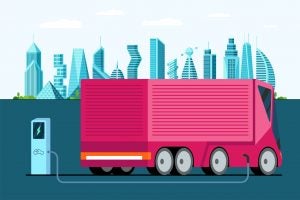 California is moving fast to replace dirty, gas-guzzling heavy-duty vehicles with cleaner, electric choices as a way to combat air pollution and climate change.
California is moving fast to replace dirty, gas-guzzling heavy-duty vehicles with cleaner, electric choices as a way to combat air pollution and climate change.
Both fleets and electric utilities need to rethink the way they build the charging stations needed to power these vehicles. Charging stations should be as affordable as possible, and help electric vehicles integrate more renewable energy into the grid. The California Public Utilities Commission is working with stakeholders to set out key guidelines, targets and metrics to reach those goals. This process, known as the Transportation Electrification Framework, is unquestionably a step in the right direction, but in order to maximize its impact there are some key things the CPUC should keep in mind.
Not all electric vehicles are created equal
Currently, the framework focuses primarily on clean passenger vehicles — the light-duty vehicles most often purchased by individual consumers. These vehicles have very different infrastructure needs than the trucks, buses and commercial-grade vehicles used to transport people and goods. Heavy-duty vehicles, because of their bigger batteries, require more power, and typically need to be charged at a dedicated depot and at specific times rather than at a public charging station. Bigger EVs also come with a higher energy demand, so utilities might have to view electric supply availability — and corresponding grid infrastructure needs — quite differently. Since electric trucks and buses still represent an emerging solution in the market, utilities should ensure the owners and drivers of these vehicles that charging stations will be sufficient in number and power to meet their energy needs.
Three things California should do to prepare for more electric trucks and buses Share on XThe transition to electric vehicles must be equitable
Large, diesel-fueled vehicles produce approximately 35% of the state’s nitrogen oxide pollution, and 25% of the particulate matter. These pollutants form smog and can cause a laundry list of respiratory problems. Early research indicates that many of the routes these trucks traverse as they carry goods from loading station to their end destination disproportionately run through economically disadvantaged communities and communities of color.
Last week, the California Air Resources Board passed a new rule that will begin to address this, by increasing the number of electric trucks and buses that are available on the market. The CPUC and the utilities must also play a role. Adding more charging infrastructure in communities where these trucks traverse most frequently is one way to encourage targeted deployment of electric trucks in communities overburdened by poor air quality. Likewise, educating fleet owners about rebates and cost-saving opportunities of medium- and heavy-duty EVs can help accelerate their deployment. When investing in the necessary infrastructure required for clean vehicles, sourcing jobs from within disadvantaged communities may create additional economic opportunities.
Plan smarter not harder
When EVs are charging, there is a lot that grid operators and utilities can learn about how much energy they use. This process is known as vehicle-grid integration. If paired with smartly designed rates that encourage charging at times coinciding with high renewable energy availability and low electric demand, it can help ensure vehicle charging remains cheaper than buying diesel fuel. Fuel savings help make EVs more affordable and also help the ratepayer take full advantage of renewable energy already on the system.
It can also ensure vehicle charging happens relatively easily without adding more demand to the grid at peak times. Some electric medium- and heavy-duty vehicles, for example, may actually provide services to the grid — such as dispatching unused energy from their batteries back onto the grid during peak demand times. Vehicle-grid integration can also play a role ensuring we are optimizing renewable energy resources by focusing charging during times when there is an abundance of renewable energy available. Figuring out how to effectively and efficiently integrate vehicles into the grid is critical to maximizing the environmental and energy system benefits of EVs. The investments we make today will establish EVs as a service provider paradigm which will be critical to maximizing the opportunity for emissions reductions and economic benefits.
By smartly deploying infrastructure that can support increased EV usage — with an eye to accommodating the particular needs of medium and heavy-duty vehicles — utilities can help establish an electrified vehicle market that lowers costs for consumers, enables a more reliable and resilient grid and maximizes environmental benefit. The CPUC, CARB and the California Energy Commission should be commended for this proactive and forward-looking approach to vehicle electrification.
California has already made tremendous strides in ensuring that EVs can contribute to a healthy economy while also cleaning the air, and the Transportation Electrification Framework could — if done right — set up the state to cement its reputation as an environmental leader.









